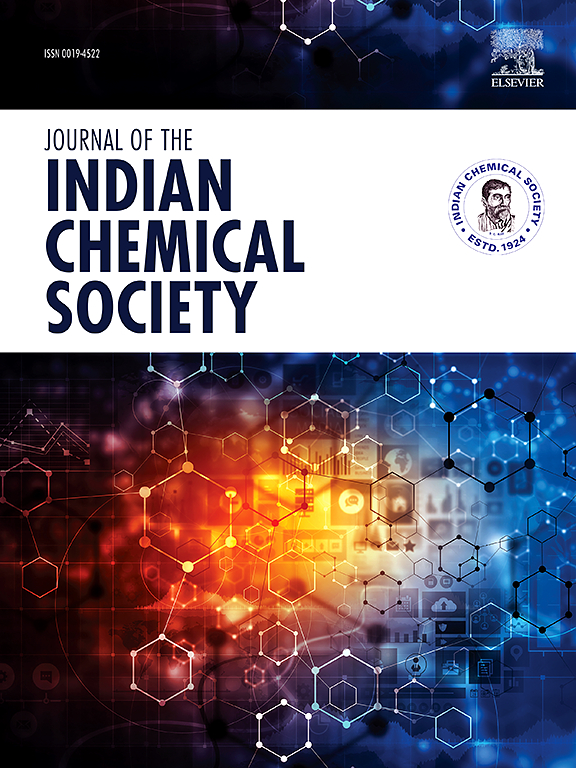Insight into the physical characteristics of novel inorganic chalcogenides MAg3Se4 (M=V, Nb, Ta) with exceptional stability using WIEN2K for its applications in photovoltaics
IF 3.2
4区 化学
Q2 CHEMISTRY, MULTIDISCIPLINARY
引用次数: 0
Abstract
We develop environment friendly, renewable and effective energy sources to address the energy difficulties owing to the depletion of fossil fuels. So, inorganic chalcogenides are most intriguing compounds in the most advanced future solar cells for effective production of sustainable energy using solar radiations. This study represents the first theoretical exploration of MAg3Se4 (M = Nb, V and Ta). We describe their structural, magnetic, optical, mechanical and vibrational properties via Wien2k code for photovoltaic devices. GGA + U is utilized due to the fact that U is a suitable solution to incorporate on-site self-interactions of the electrons. The lattice constants are given as for VAg3Se4, for NbAg3Se4 and for TaAg3Se4, respectively. These materials are semiconductors due to indirect electronic band gap of 0.92 eV (↑↓) in VAg3Se4, 1.75 eV (↑↓) in NbAg3Se4 and 2.15 eV (↑↓) in TaAg3Se4, respectively. Relatively, large cohesive energy (−3.96 eV/atom) is an indication of its structurally more stable. PDOS reveals Ag-4d and Se-4p orbitals are partaking in deep area of the valence band. Ta-d states are partaking in the conduction band beyond the Fermi level. Additionally, optical investigation reveals that these compounds barely reflect incident radiations as it strikes their surfaces. Mechanical properties demonstrate that examined chalcogenides display mechanical stability, ductile character and anisotropic behavior since its magnitude is not equal to 1. Phonons study indicates some imaginary frequency in NbAg3Se4 and TaAg3Se4 which may be caused by a specific direction of the cubic crystal structure, while no imaginary frequency is found for VAg3Se4. All these materials show thermodynamic stability because free energy graph enlarges to the negative energy range. Our results unveil that these chalcogenides can be beneficial for photovoltaics applications.

我们开发环境友好型、可再生和有效的能源,以解决化石燃料枯竭造成的能源困难。因此,在未来最先进的太阳能电池中,无机钙化物是最令人感兴趣的化合物,可有效利用太阳辐射生产可持续能源。本研究是对 MAg3Se4(M = Nb、V 和 Ta)的首次理论探索。我们通过用于光伏设备的 Wien2k 代码描述了它们的结构、磁性、光学、机械和振动特性。我们使用 GGA + U,因为 U 是一种合适的解决方案,可以将电子的现场自相互作用纳入其中。VAg3Se4 的晶格常数(埃)为 ao=5.9719,NbAg3Se4 的晶格常数(埃)为 ao=6.0972,TaAg3Se4 的晶格常数(埃)为 ao=6.1020。由于 VAg3Se4 的间接电子带隙为 0.92 eV(↑↓),NbAg3Se4 为 1.75 eV(↑↓),TaAg3Se4 为 2.15 eV(↑↓),因此这些材料都是半导体。相对而言,VAg3Se4 的内聚能较大(-3.96 eV/原子),这表明其结构更为稳定。PDOS 显示 Ag-4d 和 Se-4p 轨道位于价带的深部。Ta-d 态则位于费米级之外的导带中。此外,光学研究表明,这些化合物几乎不反射照射到其表面的入射辐射。机械性能表明,所研究的钙钛矿化合物具有机械稳定性、延展性和各向异性,因为其振幅不等于 1。声子研究表明,在 NbAg3Se4 和 TaAg3Se4 中存在一些虚频,这可能是由立方晶体结构的特定方向引起的,而在 VAg3Se4 中则没有发现虚频。所有这些材料都显示出热力学稳定性,因为自由能图扩大到负能量范围。我们的研究结果表明,这些掺杂氢化物可用于光伏应用。
本文章由计算机程序翻译,如有差异,请以英文原文为准。
求助全文
约1分钟内获得全文
求助全文
来源期刊
CiteScore
3.50
自引率
7.70%
发文量
492
审稿时长
3-8 weeks
期刊介绍:
The Journal of the Indian Chemical Society publishes original, fundamental, theorical, experimental research work of highest quality in all areas of chemistry, biochemistry, medicinal chemistry, electrochemistry, agrochemistry, chemical engineering and technology, food chemistry, environmental chemistry, etc.

 求助内容:
求助内容: 应助结果提醒方式:
应助结果提醒方式:


